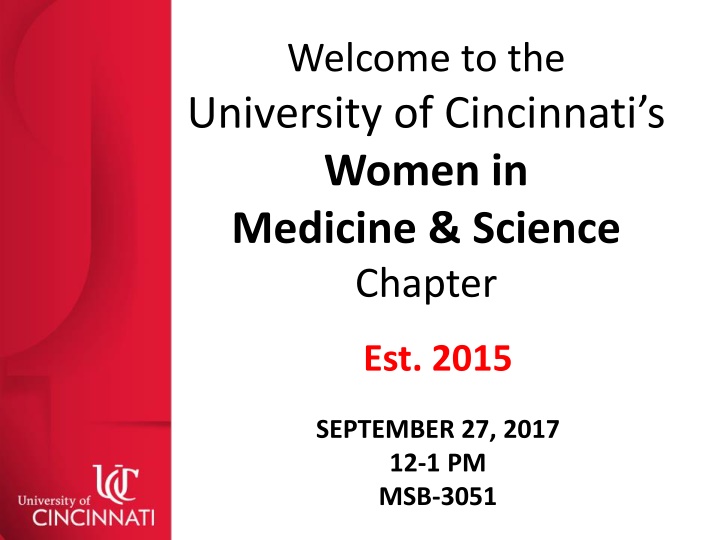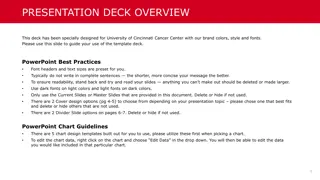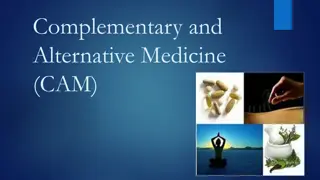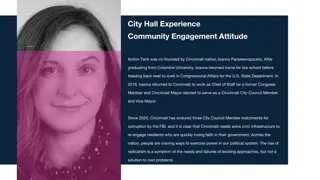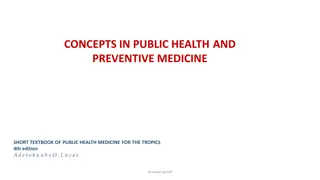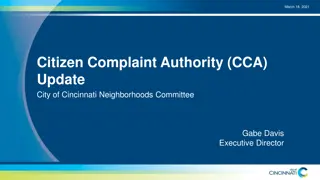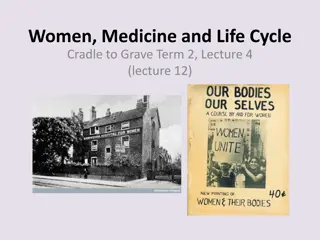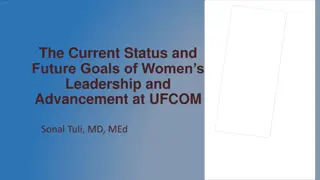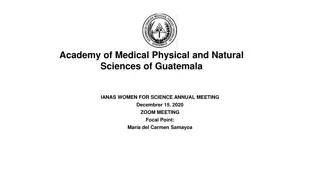University of Cincinnati Women in Medicine & Science Chapter Meeting Agenda
University of Cincinnati's Women in Medicine & Science Chapter meeting agenda includes updates, leadership roles, upcoming meetings, and discussions on important topics such as the Pink Tax Bill. The chapter aims to promote gender equity in healthcare and support women professionals in the fields of medicine and science.
Download Presentation

Please find below an Image/Link to download the presentation.
The content on the website is provided AS IS for your information and personal use only. It may not be sold, licensed, or shared on other websites without obtaining consent from the author.If you encounter any issues during the download, it is possible that the publisher has removed the file from their server.
You are allowed to download the files provided on this website for personal or commercial use, subject to the condition that they are used lawfully. All files are the property of their respective owners.
The content on the website is provided AS IS for your information and personal use only. It may not be sold, licensed, or shared on other websites without obtaining consent from the author.
E N D
Presentation Transcript
Welcome to the University of Cincinnati s Women in Medicine & Science Chapter Est. 2015 SEPTEMBER 27, 2017 12-1 PM MSB-3051
AGENDA Welcome & Introductions WIMS Leadership WIMS Fund Next WIMS Meeting Pink Tax Bill: Maria Espinola, Psy.D. ANNUAL FACULTY DATA REPORT Kelly Brunst, PhD & Liza Murrison, PhD UPDATE ON LEAF CLIMATE & SURVEY GROUPS Valerie Hardcastle, PhD
WIMS LEADERSHIP President: Erin N. Haynes, DrPH President-elect: Amy Bunger, PhD Secretary: Jennifer Forrester, MD Secretary-elect: Heather Christensen, PhD Treasurer: Mercedes Falciglia, MD Treasurer-elect: Vinita Takiar, MD Basic Science Representative: Alison Weiss, PhD Clinical Science Representatives: Jennifer Cavitt, MD & Pamposh Kaul, MD
The WIMS Fund is now open!
THANK YOU TO THE THANK YOU TO THE First Fabulous Five Fabulous Five Friends of WIMS First Friends of WIMS Amy Bunger, PhD Patricia Carey, MD Erin Haynes, DrPH Sarah Pixley, PhD Florence Rothenberg, MD
NEXT WIMS MEETING Wednesday, October 25 12-1 PM, MSB-3051 MONTH TIME 12-1 PM LOCATION MSB-3051 TOPIC SPEAKER October 25, 2017 Health Policy Update Dawn Kleindorfer, MD Valerie Hardcastle, PhD November 29, 2017 7:15-8:15 AM MSB-2001 Updates from LEAF January 31, 2018 12-1 PM MSB-2001 WIMS in the COM William Ball, MD February 28, 2018 12-1 PM MSB-2001 Negotiate Like a Girl Jane Sojka, PhD March 28, 2018 7:15-8:15 AM MSB-2001 Head Games Jane Sojka, PhD April 25, 2018 12-1 PM MSB-2001 Communicate with Power Jane Sojka, PhD May 30, 2018 12-1 PM MSB-2001 Giving an Interview UC PR, to be named
PINK TAX BILL Maria Espinola, Psy.D. Assistant Professor in Clinical Psychiatry Department of Psychiatry & Behavioral Neuroscience Primary sponsor: Brigid Kelly (D), House Representative District 31 The bill exempts from sales and use tax of feminine hygiene products principally used in connection with the menstrual cycle, e.g. tampons, panty liners, menstrual cups, and sanitary napkins. The bill seeks to address the inequity of taxing products related to health. This year, the same committee voted to exempt prescription eyeglasses, contact lenses, and other optical aids from sales and use tax, because Ohioans should not be forced to pay a tax on items they need to live healthy and productive lives. The same rationalization extends to feminine hygiene products.
ANNUAL FACULTY DATA REPORT Kelly Brunst, PhD & Liza Murrison, PhD Department of Environmental Health
2017 FACULTY DATA (FULL-TIME FACULTY - EXCLUDES AFFILIATE) AAMC Benchmark: 38% of full-time faculty are women
(FULL-TIME FACULTY - INCLUDING AFFILIATE: VA, CCHMC, CEI) AAMC Benchmark: 38% of full-time faculty are women
FEMALE (EXCLUDES AFFILIATE) Full: 19% Associate: 23% Assistant: 52% MALE Full: 32% Assistant: 39% Associate: 24% AAMC Benchmark: 21% of full professors are women
FEMALE (INCLUDING AFFILIATE: VA, CCHMC, CEI) Full: 19% Assistant: 50% Associate: 26% MALE Full: 33% Assistant: 37% AAMC Benchmark: 21% of full professors are women Associate: 26%
(EXCLUDES AFFILIATE) N (%) ASSOCIATE/VICE CHAIRS BASIC SCIENCE CHAIRS CLINICAL CHAIRS DIVISION CHIEFS FEMALE 8 (19%) 0 (0%) 4 (24%) 17 (19%) AAMC Benchmark: 24% of division chiefs are women MALE 34 (81%) 2 (100%) 13 (76%) 74 (81%) (N=19) AAMC Benchmark: 15% of department chairs are women
(INCLUDING AFFILIATE: VA, CCHMC, CEI) N (%) ASSOCIATE/VICE CHAIRS BASIC SCIENCE CHAIRS CLINICAL CHAIRS DIVISION CHIEFS FEMALE 13 (25%) 0 (0%) 5 (28%) 28 (20%) AAMC Benchmark: 24% of division chiefs are women MALE 40 (75%) 3 (100%) 13 (72%) 110 (80%) (N=21) AAMC Benchmark: 15% of department chairs are women
(EXCLUDES AFFILIATE) MALE FEMALE Instructor: 17% Instructor: 24% Assistant: 76% Assistant: 65% N (%) INSTRUCTORS ASSISTANT PROFESSORS ASSOCIATE PROFESSORS FULL PROFESSORS FEMALE 8 (38%) 34 (49%) 2 (40%) 1 (25%) MALE 13 (62%) 36 (51%) 3 (60%) 3 (75%)
(INCLUDING AFFILIATE: VA, CCHMC, CEI) FEMALE Full: 1% Instructor: 20% Instructor: 18% Assistant: 76% Assistant: 63% N (%) INSTRUCTORS ASSISTANT PROFESSORS ASSOCIATE PROFESSORS FULL PROFESSORS FEMALE 13 (45%) 56 (52%) 4 (31%) 1 (17%) MALE 16 (55%) 52 (48%) 9 (69%) 5 (83%)
(EXCLUDES AFFILIATE) MALE FEMALE Associate: 16% Instructor: 20% Full: 21% Associate: 7% Assistant: 64% Assistant: 62% N (%) INSTRUCTORS ASSISTANT PROFESSORS ASSOCIATE PROFESSORS FULL PROFESSORS FEMALE 5 (56%) 16 (38%) 4 (57%) 0 (0%) MALE 4 (44%) 26 (62%) 3 (43%) 9 (100%)
(INCLUDING AFFILIATE: VA, CCHMC, CEI) MALE FEMALE Full: 8% Full: 18% Instructor: 18% Associate: 14% Associate: 18% Assistant: 58% Assistant: 60% N (%) INSTRUCTORS ASSISTANT PROFESSORS ASSOCIATE PROFESSORS FULL PROFESSORS FEMALE 9 (69%) 30 (42%) 7 (35%) 4 (24%) MALE 4 (31%) 41 (58%) 13 (65%) 13 (76%)
NEXT STEPS Trends over time (2014, 2016 data) WIMS Data Annual Report Alignment with AAMC targets
Focus Group Discussions COM FEMALE FACULTY Valerie Hardcastle, PhD Professor, McMicken College of Arts & Sciences
2016 LEAF Survey Results Women more likely than men to affirm that: RPT guidelines do not align with professional aims Annual reviews do not help career advancement They have had negative work experiences (harassment, micro-aggressions, different standards) They are not treated respectfully when disagreeing with colleagues Their unit s do not adequately recruit and support women and diverse faculty They are satisfied with staff support
2017 Focus Groups Five Themes Emerged A Gendered Work Environment A Culture of Silence/Absence of Psychological Safety Inconsistent Unit-Level Leadership and Accountability Lack of Transparency and Participation in Governance Reward System Out-of-Whack
Gendered Work Environment Vivid examples of interactions with male faculty that could constitute gender discrimination or hostile environment for female faculty Frustration with ability to confront such behavior or hold instigators responsible Women faculty perform a larger share of institutional housekeeping service work Perceptions that research and billable time are less protected for women than for men
Culture of Silence (Absence of Psychological Safety) Do not feel safe speaking up against decisions being made (e.g., hiring, leadership, environmental concerns, and policy and practice change) Explicitly told to stay silent Penalized for speaking up
Inconsistent Unit-Level Leadership and Accountability Not a gendered issue Many leaders Do not have the support of faculty even oppose faculty Lack a successful track record Do not demonstrate support for faculty development There is no system of accountability Chairs/heads have little power Not held accountable for supporting faculty needs No procedure in place to monitor chair/head performance
Lack of Transparency and Participation in Governance Faculty Perceive Power is held by finance/business area, not heads/chairs Decisions are based solely on financial considerations There is a top-down hierarchy with little opportunity to provide input on decisions that directly affect work Administration who focus on diversity and faculty development are in limited roles and unable to fully engage in these matters
Reward System Out-of-Whack Reward system is inconsistent with RPT criteria and faculty preferences College funding model places pressure on RVUs Less time for patient care Less time for research and teaching Perceives the administration requires faculty to increase college funding at the expense of research, teaching and service missions
Recommendations from Faculty Require faculty-driven annual reviews for decanal-level and unit head administrators Adopt a chair/vice chair model (esteemed chair provides vision, vice chair has administrative and interpersonal skills to work with faculty) Require training to enhance leadership skills of chairs/heads Seek funding to invest in efforts that support climate change Better leverage, engage, and reward senior male faculty who advocate for women and URM faculty Provide follow-up Title IX training for women faculty and students; work with college leaders to limit inadvertently rewarding perpetrators
Faculty Retention 2005 - 2017
Gender Differences in Faculty Trajectories ASSISTANT PROFESSORS
Assistant Professors 2005 - 2017 UC Assistant Professors COM Assistant Professors 21% Women 49% Women 13 387 48 406 79% Men 51% Men
Assistant Professor Outcomes Gender Differences After 7 Years in Rank COM Women 5 4 4 5 COM Men 2 11 18 17 UC Women 155 9 132 91 6 UC Men 7 73 189 137 Median years to promotion 0% 20% 40% 60% 80% 100% Percent Outcomes by Type Still in Rank Promoted Gone from BU Non-Tenure Track
Race/Ethnicity Differences in Faculty Trajectories ASSISTANT PROFESSORS
Assistant Professors 2005 - 2017 COM Assistant Professors UC Assistant Professors 20% Asian 42% Asian 150 25 55% White 88 69% White 12% URM 522 33 2 3% URM
Assistant Professor Outcomes Race/Ethnicity Differences After 7 Years in Rank 4.5 COM Asian 2 4 11 8 COM URM 2 5 COM White 8 11 14 5.5 6 UC Asian 2 21 82 45 UC URM 1 17 47 23 UC White 6 190 115 204 13 0% 20% 40% 60% 80% 100% Median years to promotion Percent Outcomes by Type Still in Rank Promoted Gone from BU Non-Tenure Track
Gender Differences in Faculty Trajectories ASSOCIATE PROFESSORS
Associate Professors 2005 - 2017 UC Associate Professors COM Associate Professors 48% Women 32% Women 24 292 68% Men 50 316 52% Men
Associate Professor Outcomes Gender Differences After 10 Years in Rank 7.5 6 COM Women 12 2 9 1 COM Men 22 18 9 1 6 6 UC Women 192 59 39 2 UC Men 2 191 83 40 Median years to promotion 0% 20% 40% 60% 80% 100% Percent Outcomes by Type Still in Rank Promoted Gone from BU Non-Tenure Track
Race/Ethnicity Differences in Faculty Trajectories ASSOCIATE PROFESSORS
Associate Professors 2005 - 2017 COM Associate Professors UC Associate Professors 32% Asian 17% Asian 23 100 74% White 62% White 424 44 53 4 9% URM 6% URM
Associate Professor Outcomes Race/Ethnicity Differences After 10 Years in Rank 4.5 6.5 COM Asian 2 12 7 2 COM URM 2 2 6.5 COM White 14 19 11 5 7 UC Asian 63 11 2 24 UC URM 32 11 10 UC White 6 2 261 56 105 0% 20% 40% 60% 80% 100% Median years to promotion Percent Outcomes by Type Still in Rank Promoted Gone from BU Non-Tenure Track
